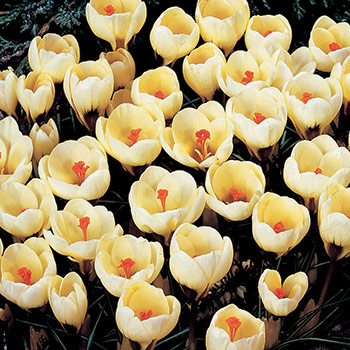
For a gardener, there are few sights as welcome as the first crocus of the year, peeking its flowers through the freshly melted snow of late winter. Crocus is a very hardy perennial and one of the few plants that can bloom as early as February or March. By being hidden deep in the soil, crocus corms are naturally insulated from severe temperature changes, ice and wind. Flowering is initiated by just a few consecutive days of temperatures above freezing. Once the first few inches of soil can thaw, flowers emerge and will last for several weeks despite more wintry weather. Crocus flowers can protect themselves by closing up in the evening and also whenever they experience severe weather.

Crocus have long been popular with gardeners for several reasons. Their durable flowers are available in many colors including yellow, white, purple, blue, and pink. One plant will usually return year after year and develop offspring that can produce additional flowers in beautiful drifts. The two-inch flowers are made up of 6 oval petals that surround 3 prominent yellow to orange stamens. Crocus grow from one-inch corms rather than actual “bulbs.” Both are just compressed stems: bulbs consisting of fleshy scales and corms being more solid. Gladiolus is another example of a corm.

Crocus are native to the rocky slopes of the Mediterranean countries and southwest Asia. They adapt to cold winters, full or partial sun, and well-drained soil. Most Michigan gardeners have the first two, but well-drained soil may have to be created if clay is prevalent. Drainage can be improved by adding aged pine bark or compost to your soil. Since crocus corms are planted 3 to 4 inches deep, only about 4 inches of soil below them needs to be well-cultivated. Corms should be at least 3 inches apart. However, this is the type of bulb that looks great planted in more natural and random masses.

Most crocus have only one serious threat to their perennial existence. Hungry bunnies seem especially tempted by the leaves, flowers and corms of several species. Corms can be protected by several methods. Gravel worked into the soil above the corms will make digging them up difficult. Liquid or powder deterrents can be used to treat corms before planting. Keep in mind that freshly planted bulbs and corms are most likely to create curiosity amongst browsers. Once established, they are rarely disturbed. If all else fails, you can plant in below-grade, wire mesh cages that are impenetrable. To protect leaves and flowers, apply a granular deterrent or a spray.

There are many varieties of spring-blooming crocus but most of the hardy ones fall into four species. Crocus ancyrensis is golden bunch crocus. The selection ‘Golden Bunch’ produces up to five deep orange-yellow flowers in a “bunch” per corm. Of the four species, this is one of the earliest to bloom; late February is not unusual if Mother Nature is cooperating. This is also one of the more vulnerable to attack from the bunnies.

Crocus chrysanthus is available in several varieties, all of which are referred to as snow crocus or golden crocus. ‘Cream Beauty’ is a strong grower that is primarily white with a white center. ‘Ladykiller’ is also white but with purple on the outside of the petals. ‘Advance’ is yellow inside but the outside is unique because the petals alternate creamy yellow and purple. Corms produce 1 to 4 flowers each in late February or early March. Like C. ancyrensis above, rabbits admire this species.
Crocus tommasinianus is a wonderful choice for several reasons. This species is the most pest-resistant crocus available. If you have lost crocus to rabbits or squirrels, this may be the choice for you. C. tommasinianus is also the most prolific grower. It will quickly naturalize to form masses of flowers. The most readily available variety is ‘Barr’s Purple.’ Its deep violet petals fade to a bright white center that is highlighted by bright orange stamens. It blooms almost as early as the above two species, usually in early March.
The most popular species is Crocus vernus or Dutch crocus. Unlike the previous species, one large flower with large gold stamens is produced from each corm. It is available in several colors ranging from white to stripes to purples. ‘Jeanne d’Arc’ is a bright white with large flowers. ‘Pickwick’ has large white flowers with dark lavender stripes inside and out. ‘Remembrance’ and ‘Flower Record’ are deep lavender and pale lavender respectively. Dutch crocus usually bloom from March to early April.
Fall is a perfect season for planting. Cooler weather means less heat stress for both plants and people. Plants are naturally becoming dormant and are far less susceptible to drying out and experiencing transplant shock. Fall is also the only season for planting spring-blooming bulbs and corms. Once the ground freezes, the opportunity is lost and you’ll regret not having these heralds of spring glowing in your early season garden. Crocus are relatively inexpensive and are available almost anywhere bulbs are sold. With minimal effort this fall, you can enhance your existing landscape and welcome spring with the bright blossoms of crocus.

Crocus CRO-kus
Plant type: Corm (commonly referred to as a “bulb”)
Plant size: 3-5 inches tall
Habit: Clump-forming
Flower colors: Purple, violet, reddish- purple, lilac, yellow, cream, white
Flower size: 2 inches wide
Bloom period: Late winter to early spring
Light: Full to partial sun
Soil: Well-drained
Uses: Plant in natural drifts in the perennial border, lawn or rock garden
Remarks: The corms develop offspring that can produce additional flowers to create a naturalized look
George Papadelis is the owner of Telly’s Greenhouse in Troy and Shelby Township, MI.
RELATED: Colchicum and Fall Crocus
ELSEWHERE: More on Crocus at Chicago Botanic Garden

Leave a Reply